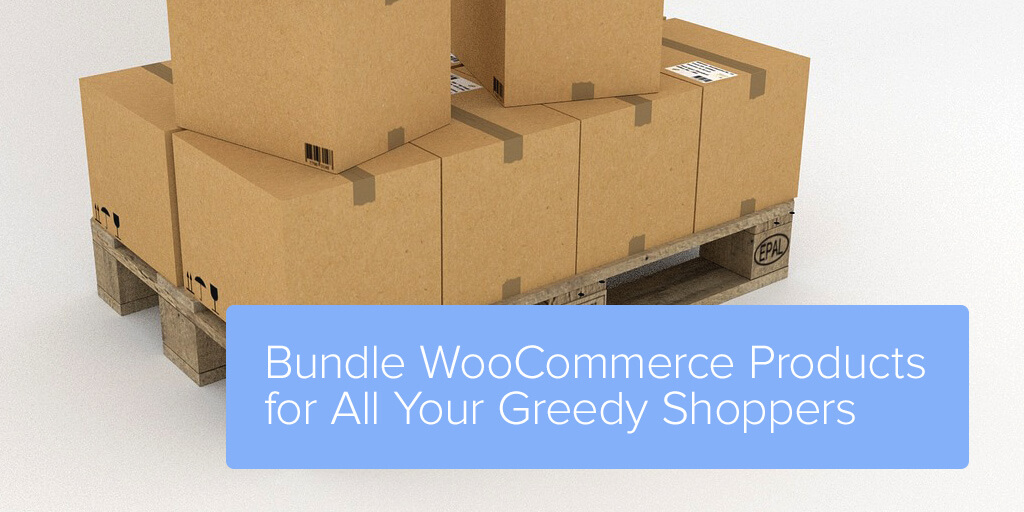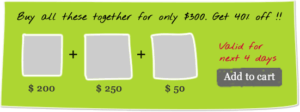
Do you want to increase profits and improve customer satisfaction?
Silly question, we know. But the reason we ask is that many ecommerce stores often overlook a simple competitive pricing strategy that could easily incentivize more purchases, they just never do it.
It’s called bundling, and if you’re not already doing it, you should be. Here’s why.
The Power of Bundling
Bundling is exactly what it sounds like: Combining similar products together into one kick-ass product.
The reason bundling is so appealing from a consumer perspective is that customers are inherently greedy. They want the most value for the least amount of money, which bundling gives them.

They’re essentially receiving way more value for their single purchases than they would by buying each product individually, and they usually save a bit of money in the process. They also don’t have to waste time searching for other products that they may need, which means they’re more likely to return to your store to find what they’re looking for in the future.
From a business perspective, bundling is great because you’re making more money on the total value of the order. Sure, you may lose some margin here if you’re offering an extreme discount, but you also have the potential of selling more products.
But how exactly do you bundle? Maybe your products don’t readily lend themselves to bundling, or you’re not exactly sure which products to combine with others. Well, take a deep breath.
There are several ways you can approach it.
Bundling Techniques to Try
If one bundling strategy won’t work for your products, chances are that another will. Here are a few options you can try to maximize your earning potential.
Pure Bundling
Pure bundling is where you offer certain products that are only available in a bundle. Customers either won’t be able to find them separately, or wouldn’t necessarily need or want to purchase them separately.

A real life example of this would be cable providers bundling their channels together, or how Adobe or Microsoft bundle their software services together in one suite. The plus side is that customers purchase products they would otherwise never consider.
If you have several products that work really well together (or really don’t work well without each other), consider packaging them together as one offering. You can even use subscription pricing with pure-bundled products, like how Microsoft Office 365 uses a month-to-month subscription.
Mixed Bundling
Mixed bundling is similar to pure bundling except customers can also purchase the products individually. This is probably the most popular type of bundling out there, and for good reason. Mixed bundling gives customers the option to purchase products individually, so even if they can’t decide on your bundle, you’re still more likely to make a sale.
The goal here is to:
- Choose products that are already best sellers, so you can charge a special price to package them together
- Choose products that are okay sellers individually, but would be a better deal for the customer if sold together
- Choose one product that sells well and another that doesn’t sell well, so that you can sell more of both products
The nice thing about mixed bundling is that shoppers often can’t resist a great deal. If they’re already paying for something they want, and they get a little something extra along with it, they’re more than happy to spend a few extra dollars.
Cross-Sell Bundling
If you’ve ever shopped on Amazon, you’ve seen an example of cross-sell bundling. They usually have a section on each product page with items that are “Frequently Purchased Together” featuring the original product along with other recommended products.

This can work well for many online shops depending on what you sell. But, even if you don’t necessarily have products that are “frequently purchased together,” you can use data and analytics to bundle products that could be purchased together.
By analyzing customer data and tracking product performance, you can create “recommendations” based on other products you think would benefit the customer. You can also create groups of users who may be more interested than others in purchasing your bundle, and target them specifically.
If you have two or more products that could benefit from being used together, or you have products that could benefit a single user group, consider cross-promoting them as a bundled offering.
Bundling in WooCommerce
The good news for WooCommerce users is that they offer a variety of bundling options like:
- Product Bundles – Where you can create combos of bundled products
- Chained Products – Where you can gift other products to customers when they make a purchase
- Forced Sells – Where you can required certain items to be bundled, like a service and a part, for example
- Grouped Products – Where customers can directly add items to their cart from a range of products
- Mix and Match Products – Where you can bundle up products based on customer preference, like picking the different fruit they want in a fruit basket, for example
- Composite Products – Where customers can select between different, compatible product alternatives and adjust quantities as needed
WooCommerce also has documentation, tips, and additional tricks for helping you bundle your products together here. (Of course, if you need more help with specific bundling advice, we’re always available to help.)
Other Considerations
If and when you’re ready to start bundling, there are a few other details you may want to keep in mind.
Focus on customer experience. As much as possible, tailor the experience to your customer’s needs and wants. Give them options to customize, add, remove, or edit products from your base bundles if possible. This will make the buying process more satisfying overall.
Mitigate decision exhaustion. Customers are a fickle bunch, and while they love choices, they don’t want to be overwhelmed by a million options all at once. So even though they want the ability to customize their bundles, you shouldn’t necessarily provide them with every option out there.
Make sure you direct customers toward choices you think would be beneficial, and eliminate anything that would confuse them or otherwise keep them from buying the bundle outright. The best way to do this is by recommending bundled options. You get the benefit of eliminating decision-making from customers while also being seen as the “authority” on what products go best together.
Use customer feedback to drive confidence. It’s important to let the customer drive his or her own experience. You certainly don’t want to force them to purchase a bundle if they don’t want to (that’s why mixed bundling is more popular than pure bundling).
You can also use customer feedback to help with this while first starting out. If your bundling endeavor is a success, you can also use feedback to help drive confidence for other customers considering purchasing bundled items.
Final Thoughts
Bundling can be a great solution to improve your bottom line while giving something of value to your customers.
Remember that not all of your products need to be bundled together, but if you have some products that you believe really should be purchased together, offer them as a bundle at a competitive price. (This also works for products that aren’t selling as well as they should.)
You can choose from any type of bundling to fit you and your customer’s needs, just remember to get feedback during the process to see what works and what doesn’t work. Use that feedback to create better bundles and to boost confidence for customers looking for a good deal.